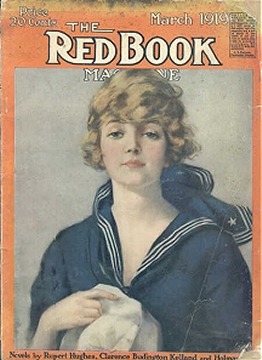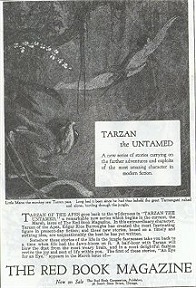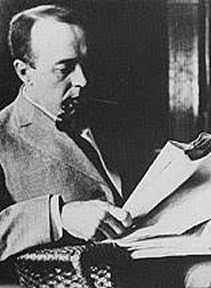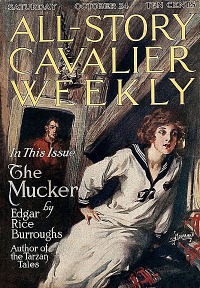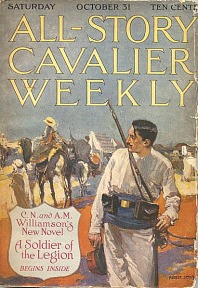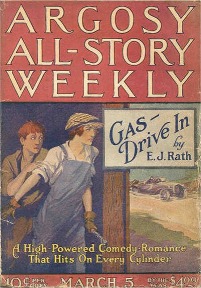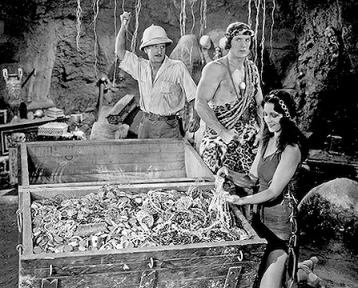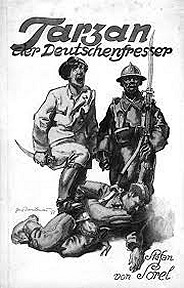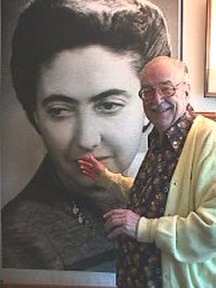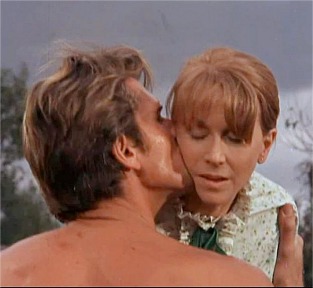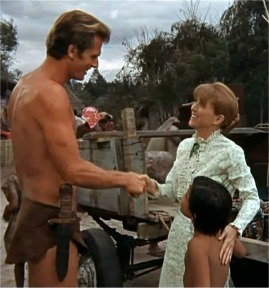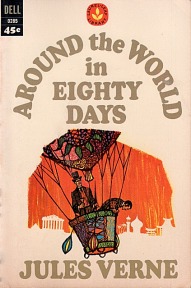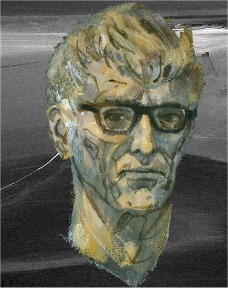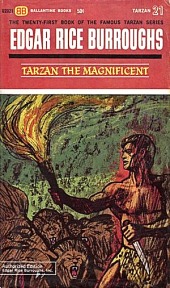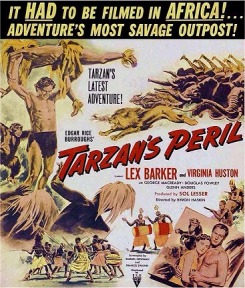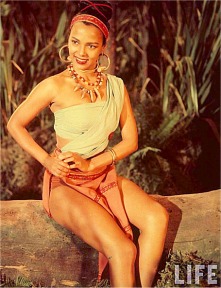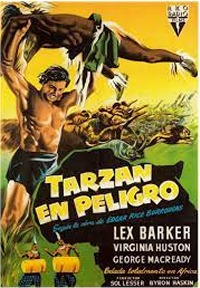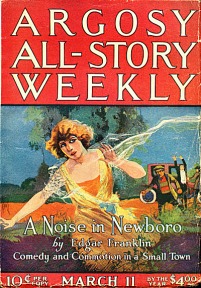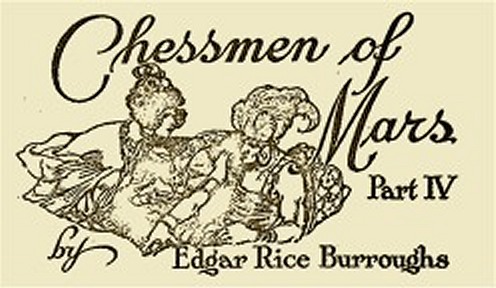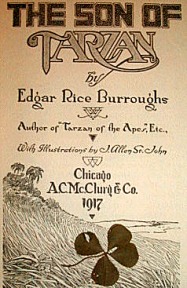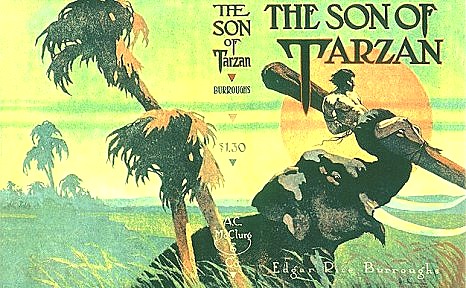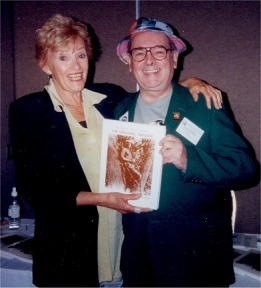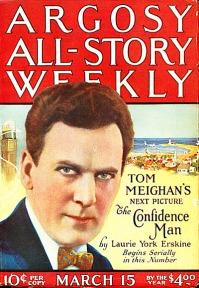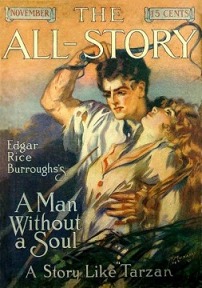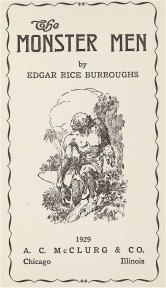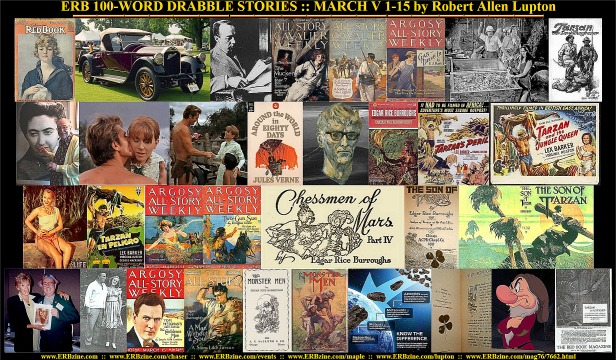
Official Edgar Rice Burroughs Tribute and Weekly Webzine Site Since 1996 ~ Over 15,000 Webpages in Archive Volume 7662  |
ERB 100-Word Drabbles
MARCH V Edition :: Days 1-15
by Robert Allen Lupton
See Days 16 - 31 at ERBzine 7662a
With Collations, Web Page Layout and ERBzine Illustrations and References by Bill Hillman
MAINTENANCE PROGRAM
March 1: On this day in 1919, Redbook Magazine published the first installment of “Tarzan the Untamed.” There were a total of six monthly installments. The first half of what would become the novel of the same name never made the cover, but Charles Livingston Bull drew a total of twenty-five interior illustrations. The second half of “Tarzan the Untamed” was titled “Tarzan and the Valley of Luna” first published in All-Story Weekly in March and April of 1920.
I wrote an article about “Tarzan the Untamed. I was astonished by the body count. Tarzan kills more Germans than I could keep track of – and I tried. I tried page by page. If you count the solders killed when Tarzan releases lions in their trenches, the count is even higher. Of course, Tarzan believes that the Major Schneider led the attack on his estate and killed Jane and he fed the good major to a lion.
Read all about the book and the publishing details at: https://www.erbzine.com/mag4/0493.html
The drabble for today is Maintenance Program, and it was inspired by Tarzan’s quest to revenge the death of his wife, Jane, who hadn’t been killed but only kidnapped. A difference that probably wouldn’t have mitigated his anger. Credit to Stieg Larsson (Girl with the Dragon Tattoo) for the ‘absolute duty’ quote.Tarzan and Bertha Kircher, a German agent who’s actually an English spy, found a dead German officer’s diary and learned that Jane still lived. MAINTENANCE PROGRAM
Bertha said, “You killed hundreds of men to revenge the murder of your wife. She isn’t dead.”
“The fact that she was kidnapped doesn’t lessen their crime.”
“No revenge is as satisfying as forgiveness.”
“Insanity, to exact revenge for yourself or your friends is not only a right, it’s an absolute duty.”“They probably wouldn’t have kidnapped anyone else.”
“I know they won’t. Don’t think of their deaths as revenge. Think of it as preventive maintenance.”
FIRST LABOR DISPUTE
March 2: According to www.erbzine.com, on this day in 1923, Edgar Rice Burroughs incorporated himself as Edgar Rice Burroughs Incorporated. The move was intended to cut down on taxes. Edgar Rice Burroughs assigned all literary rights to the corporation and the ownership shares were distributed among his family.
The 100 word drabble for today, ‘First Labor Dispute’ and it was inspired by ERB’s incorporation and the distribution of shares to his family.Ed’s incorporation attorney said, “Hold a shareholders’ meeting and explain this to your family.” FIRST LABOR DISPUTE
Ed called the meeting. His wife, Emma, fifteen-year-old Joan, fourteen-year-old Hulbert, and ten-year-old John Coleman attended. After ERB explained, John Coleman asked, “If Dad’s a company now, is he still our father?”
“Of course I am.”
Joan said, “Dad works for the company and we own the company? So we’re his bosses?”“I suppose it does.”
“Dad needs to work harder and buy me a Pierce-Arrow for my sixteenth birthday.”“Slow down. I’ve never been a union man, but I think I may go on strike!”
MUCK ADO ABOUT NOTHING
March 3: On this day in 1914, All-Story Magazine purchased “The Mucker” for $1,450.00. The first installment of the serialized publication of the story began later that year in All-Story Cavalier Weekly on October 24, 1914. The cover was by P. J. Monahan.
The issue included part three of “Malay Gold” by H. Bedford Jones, part four of “The Curious Quest of Mr. Earnest Bliss” by E. Phillips Oppenheim, and part two of “The Ladder Jinx” by Edgar Franklin.
Publishing details, several illustrations, and an electronic version of the novel are located at: https://www.erbzine.com/mag7/0757.html
Definitions and use of the word mucker vary around the world. It can be a vulgar, ill-bred person, a person who often says or does the wrong thing, or a person who removes debris, rocks, and other waste material (especially in mines or stables.) In the UK, the term means a friend or a friendly soldier or low rank.
An obsolete use of the word is in the phrase, ‘go a mucker,' and it means to ruin one’s future by one’s own behavior. ‘He got drunk and went mucker last night. This morning he was sacked.’
Muckerism, is a term for unfair play in a sporting event (cheating). The word origin is considered to be German, meaning a sulky person.
The drabble for today is, “Muck Ado About Nothing,” and it was inspired by ERB’s novel, “The Mucker,” and some of the definitions of the word.Lord Greystoke and Billy Byrne met near Mexico.Greystoke said, “Hey, old mucker, help herd these cattle.” MUCK ADO ABOUT NOTHING
“Who you calling mucker? Them is fighting words.”
“In England, mucker means friend. Now stop mucking about and help.”
“Stop being friendly?”
“It also means sulky crybaby.”
Billy clenched his fists. “In America, it’s a bad stupid man who can’t get out of his own way."
“Don’t go mucker and ruin this. We can be friends.”
“I ain’t your frito!”
“The word is amigo. Don’t go amuck. Help me.”
“Nope,” said Billy and he rode away. ‘You stay the muck away from me.”
BEACHCOMBERS
March 4: On this day in 1958, the John Celardo illustrated and Dick van Buren daily comic story arc, “Tarzan and the Strandlopers” began. The story ran for sixty daily episodes. For those readers like me, who had no idea what Strandlopers are, www.dictionary.com defines the word as: an extinct tribe of Khoikhoi or Bushmen who lived on sea food gathered on the beaches of southern Africa. The word is Afrikaans and Dutch for ‘beach walker.’
Most Strandloper communities did not survive the demographic and economic changes in southern and south-western Africa during the 19th and 20th centuries, and disappeared through assimilation.
However, in this story, the Strandlopers are a missing link, creatures somewhere between apes and mankind. Tarzan and a group of scientists find several large meteorites barely covered in sand along the beach. Evidently the meteors landed softly. The first Strandloper doesn’t make an appearance for a few weeks into the story arc. Here’s a reproduction of that page. The creatures, who are eight-feet tall, only appear a dozen or so of the installments.
The geologists realize the value of the meteorites and force Tarzan, among others, to help them take the meteorites. Forcing Tarzan to do anything he doesn’t want to do rarely works out well and this is no exception.
In the story, the meteorites are referred to as ‘meteors. By NASA's definition, once a meteor has survives its passage through Earth’s atmosphere, it becomes a meteorite. Simply, if it’s on the ground, it’s a meteorite. If it’s lighting up the sky in its fiery passage, it’s a meteor.
Read the entire story arc at: https://www.erbzine.com/mag43/4323.html
The drabble for today is “Beachcombers,” and it was inspired by the story arc, “Tarzan and the Strandlopers.”The scientist said, “These large stones are meteors and the creatures guarding them are Strandlopers, the missing link between apes and men.” BEACHCOMBERS
Tarzan said, “No, these are meteorite. Meteors burn up in the atmosphere. Meteorites survive the journey to reach the surface. Strandlopers are a peaceful beachcombing tribe.”
Dick Green, the expedition’s leader snarled, “I was graduated with highest honors from Harvard.”
Bart, another scientist said.” I matriculated at MIT. Don’t question me!”
Tarzan replied, “The jungle and I don’t care where you went to school. I’d hoped you’d be smart explorers. The jungle kills the stupid ones so quickly.”
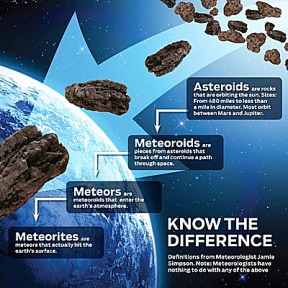
LOCK AND LOAD
March 5: On this day in 1921, Argosy All-Story Weekly published the fourth installment of “Tarzan the Terrible.” The serialization ran for seven issues and only the first issue featured Edgar Rice Burroughs on the cover, illustrated by P. J. Monahan. The cover for this issue illustrated the first installment of “Gas-Drive In” by E. J. Rath the pseudonym of Chauncey Corey & Edith Brainerd. The infamous Captain Dingle, aka Albert Edward Dingle, contributed the story “Mean and Useless.”
The cover blurb for “Gas-Drive In” calls it “A High-Powered Comedy Romance That Hits On Every Cylinder.”
In Tarzan the Terrible, Tarzan has discovered that Jane is still alive and he tracked her and her captors through the jungle. Meanwhile a man whose identity isn’t revealed tracked Tarzan. The man carries a rifle and ammunition which he never uses no matter the dangers he faces, choosing to save them until later. (SPOILER ALERT) The man is Korak and he uses the weapon to save his parents.
Publishing details about “Tarzan the Terrible,” abound at: https://www.erbzine.com/mag4/0494.html
The drabble for today is “Lock and Load,” and it was inspired by “Tarzan the Terrible,’ possibly the best book in the series – certainly my favorite. Tarzan never hesitated to kill to protect himself, his family, or his friends.Korak arrived as Tarzan was being sacrificed, loaded his rifle, and laid waste to Tarzan’s and Jane’s captors. LOCK AND LOAD
Jane hugged her son. “Son, you killed them all.”
“Just as fast as I could. They were going to kill father and who knows what terrible fate they had planned for you. There wasn’t time for debate. The truly violent don’t understand anything except violence, and such violent problems require violent solutions. You can’t stop invaders or murderers with words. The wolf feeds while the sheep talk.”“The time for talk is after you survive.”
“The dead lion doesn’t kill any deer.”
TIGER, TIGER, BURNING BRIGHT
March 6: On this day in 1930, the fifteenth and final episode of the film serial, “Tarzan the Tiger,” starring Frank Merrill and Natalie Kingman, was released in both silent and ‘talkie” versions. The talking version included music and what was perhaps the worst Tarzan yell every recorded. Here’s a link to the yell: https://www.youtube.com/watch?v=OvEPfFnp0Wo
Details and photographs about the film: https://www.erbzine.com/mag5/0593.html
The final episode was a busy one. It began with Albert Werper (Al Ferguson) attacking Tarzan with a knife. Tarzan stopped him, only to be held at gunpoint by Annersley (Clive Morgan). The pair tie Tarzan to a tree and forced Jane to lead them to Opar.
Tarzan calls the elephants, who untie him. The evil Philip Annersley is killed by a tiger. Yes, a rare African tiger! Another tiger, or perhaps the same one, kills Werper. Tarzan and Jane remove the stolen jewels from Werper’s corpse and use the money to save The Greystoke estate.
Tarzan said, “Fear is now gone and love will remain with us forever.” Roll the credits.
The 100 word drabble for today is “Tiger, Tiger, Burning Bright,” inspired by the film.Tarzan and Jane knelt over the tiger-shredded body of Albert Werper and removed all the jewels the man had stolen from Opar. Jane asked, “Tarzan, will we return these jewels to Opar?” TIGER, TIGER, BURNING BRIGHT
“We’ll sell them and payoff the mortgage on the family estate. That was a strangely striped lion that killed Werper.”
=
“That was no lion, it was a tiger.”
“Jane, there’re no tigers in Africa.”
“Nonsense, I’ve been to the Nairobi Zoo.”
“Why would the tigers escape and kill this man.?”
“Didn’t you call the tigers for help the way you called the elephants?”
“No, I don’t speak tiger.”
TARZAN, THE GERMAN-EATER
March 7: On this day in 1970, Wendy Wahrman, Mrs. Forrest Ackerman, wrote a letter to Darrell Richardson, aka The Old Tiger. Darrell had requested that she translate the 1925 German article, “Tarzan, the German-eater,” written by Stefan Sorel (pen name of publisher Carl Stephenson.)
The article was highly critical of ERB’s treatment of Germans. The article is quite lengthy, but the translation by Wendy Wahrman may be read in its entirety at: https://www.erbzine.com/mag32/3296.html and https://www.erbzine.com/mag32/3297.html
The article was originally titled “Tarzan der Deuschenfresser,” which could be translated as “Tarzan the German-Devourer,’ and was published by the Carl Stephenson Publishing House in Berlin. The article was an direct attack ERB’s work, particularly “Tarzan the Untamed” and it called for banning ERB’s works in Germany, “Only one solution seems advisable: Let Mr. Burroughs' name and his work sink into silence and total oblivion. A continued flooding of the German market with Mr. Burroughs' books would simply be despicable and undignified for a nation thus insulted by him.”
On another note, while Wendy was unable to determine the identity of Sorel in 1970, later information revealed the Sorel was Carl Stephenson, who wrote the excellent short story, “Leiningen versus the Ants,” which was the basis for the Charlton Heston film, “The Naked Jungle.”
The drabble for today is taken from the letter from Mrs. Ackerman to Darrell Richardson. Read the entire letter here: https://www.erbzine.com/mag32/3295.html“Here’s the long overdue translation of Sorel's "Tarzan, the German-eater." I tried to remain as faithful to the original language. Sorel's style is very heavy, with cumbersome sentence structure; but he also indulges in rather sloppy, slangy language, when he attempts to be sarcastic. You can feel in his patronizing remarks addressed to ERB how superior he believes himself to be. His work doesn’t justify the high esteem he has of himself. TARZAN, THE GERMAN-EATER
I have tried to find out who Sorel was. I couldn’t find any reference to him in several histories of German literature. He might have been a journalist.”
PLANT TODAY, REGRET TOMORROW
March 8: On this day in 1968, the 54th episode of the of the Ron Ely Tarzan television series appeared. It was part two of the story, “The Four O’clock Army,” and it featured Julie Harris, Maurice Evans, Bernie Hamilton, Guy Edwards, Phil Posner, and Bruce Gordon. Ron Ely and Manuel Padilla Jr. played Tarzan and Jai respectively. It’s not that often that an eleven time Emmy winner and five time Tony winner appear in an episode of Tarzan, although Harris made four appearances as Charity Jones in the series.
Written by Carey Wilber and directed by Alex Nicol, the episode requires Julie Harris (Charity Jones) to work with General Bertram (Maurice Evans) and Tarzan to rescue the villagers captured by slavers.
Details about the entire Ron Ely Tarzan television series are at: https://www.erbzine.com/mag74/7420.html
The drabble for today, Plant Today, Regret Tomorrow,” was inspired by the episode, “The Four O’clock Army, of the Ron Ely Tarzan television series.Charity Jones confronted the slavers who were ransacking her village. The men pushed her aside, destroyed her garden, and packed her supplies into packs for their captives to carry. PLANT TODAY, REGRET TOMORROW
The leader said, “Take everything we can use and burn anything we can’t.”
“One man said, “Little seeds too small to eat. What are they?”
Charity said, “Bird seed. I love when birds fill my garden.”
The leader looked shocked. “Bird seed, you say? How long does it take after planting for the seeds to grow into birds?”“Longer than for vengeance to sprout from your evil. Reap what you sow!”
LEAD THE WAY
March 9: On this day in 1996, Artist Richard M. Powers died in Madrid, Spain. Powers illustrated twenty-two Tarzan novels for Ballantine Books. He also illustrated iconic covers for hundreds of paperback editions of science fiction and fantasy novels, including but not limited to ‘Pebble in the Sky” by Isaac Asimov, “Rogue Queen” by L. Sprague D. Camp, “Tomorrow the Stars,” by Robert Heinlein, “Childhood’s End” by Arthur Clarke, “Catseye” by Andre Norton, “Invasion of the Body Snatchers” by Jack Finney and “The Alley God,” “To Your Scattered Bodies Go,” and “Night of Light,” by Philip Jose Farmer.
100s of his cover images are available to view online at: www.richardpowers.com
More information about the artist is at: https://www.erbzine.com/mag45/4506.html
Richard Michael Gorman Powers is a member of the Science Fiction Hall of Fame and the Society of Illustrators Hall of Fame.
The 100 word drabble for the day, "Lead the Way," is excerpted from a review by Randy M. Dannenfelser. It was written about the book, “The Art of Richard Powers,” by Jane Frank published in May 2001.
The entire review is available at: http://www.infinityplus.co.uk/nonfiction/powers.htmIf Science-Fiction in the late forties to the mid-sixties went through its greatest period of maturation, there couldn’t be a more appropriate artist to associate with this change than Richard Powers. An iconoclast by nature, Powers refused to create mundane, commercialistic artwork, "just to make a buck". Instead, he gravitated toward the surrealists of his day, especially the styles of Miró, Matta and Tanguy, and used their influence to bridge the gap between abstract painting and commercial art. With the support of the daring young publisher Ian Ballantine, Powers set the standard for science-fiction paperback artwork for years to come. LEAD THE WAY
FOREVER YOUNG
March 10: On this day in 1951, the Sol Lessor produced film, “Tarzan’s Peril,” starring Lex Barker and Virginia Hudson, was released. Dorothy Dandridge played “Melmendi, Queen of the Ashuba” in the 78 minute film.
This was the first Tarzan movie partially filmed in Africa, although most of the film was shot in the United States. Locations included Mount Kenya, Death Valley, The Iverson Ranch and LA Arboretum and Botanic Garden in Los Angeles. Some previous Tarzan films used footage filmed in Africa for other movies, Trader Horn for example.
This movie allegedly had three alternate titles, “Jungle Queen” and “Tarzan and the Jungle Queen,” and “Tarzan’s Mate in Peril.” The only one I could verify was “Tarzan and the Jungle Queen.”
Prolific details about the film are to be found at: https://www.erbzine.com/mag19/1951.html
The drabble for today, “Forever Young,” is a fictional exchange between the actors on the “Tarzan’s Peril” set. Actual quotations are used herein.”Dorothy Dandridge asked Lex Barker, “Will this be your last Tarzan film.” FOREVER YOUNG
“Of course not. If my muscles hold up and my waistline keeps down, I can play Tarzan till I’m fifty.”Virginia Hudson complained, “That works for men. Guys play leading men until they need a cane to walk. Maturing female actresses end up playing someone’s aunt or mother.”
Lex said, “That’s not my fault. How about it, Dorothy, you plan on playing my aunt in a few years.
Not me, I’m gonna stay young and beautiful until the day I die!”
“That makes two of us,” Lex replied.
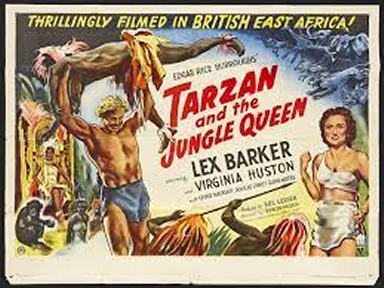
WHEN IN ROME
March 11: On this day in 1922, Argosy All-Story Weekly published the fourth installment of my favorite Edgar Rice Burroughs’ novel, “The Chessmen of Mars.” Frederick Small painted the cover to illustrate the story, “A Noise in Newboro” by Edgar Franklin. Each installment featured a black and white interior headpiece by Roger B. Morrison. The issue also contained installments of “Gun Gentlemen” by Max Brand and “Two-Gun Sue” by Douglas Grant. I’ve included the P. J. Monahan cover for “Two-Gun Sue” because I liked the story’s title.
Countless details about “The Chessmen of Mars,” its publishing history, and several illustrations are at: https://www.erbzine.com/mag4/0426.html
The drabble for today, “When in Rome.” Thanks to Arthur Brian Cooper and St. Patrick for the drabble's inspiration.Gahan of Gathol played a live version of Martian chess, Jetan, and killing several opponents, he won. The citizens applauded and cheered. The ruler called Gahan forward. WHEN IN ROME
“My people honor such warriors as you with a ritual.”The ruler and citizens chanted. Gifts were placed at the warrior’s feet. The ruler shook his spear high in the air and when the chant concluded, stabbed it into the ground and inadvertently into Gahan’s foot.
Gahan remained stoic. The ruler saw his bleeding foot. “Why didn’t you say something?”
“I’m not from here. I thought it was part of your damned ceremony!”
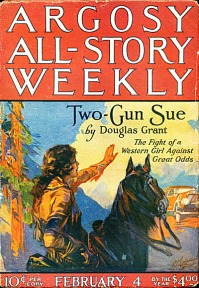
DAMN EDITORS
March 12: On this day in 1917, Edgar Rice Burroughs wrote to publisher, A. C. McClurg, complaining that his newest published novel, “The Son of Tarzan” was missing the dedication to his son, Hulbert. McClurg added the dedication page to subsequent printings/editions. This makes identification of a true first edition of “Son of Tarzan” one of the easiest of the ERB books. If it says, A. C. McClurg & Co. 1917 on the title page and doesn’t have a dedication page to Hulbert, it’s a first edition. McClurg published 2nd, 3rd, and 4th printings of the novel – all of which have the dedication page.
As the attached photos show, the appearance of "1917" on the Title Page indicates this book to be a first or second printing. The photo on the right shows this book to be the first state of the first edition as it lacks a dedication page to "Hulbert Burroughs."
Publishing history, several cover illustrations, including the original by J. Allen St. John, and the entire text of the novel are located at: https://www.erbzine.com/mag4/0487.html
The drabble for today is, “Damn Editors,” and it was inspired by this incident.“Hulbert,” said Edgar Rice Burroughs. “I promised to dedicate “Son of Tarzan” to you. For some reason the publisher left out the dedication page. They’ve promised to fix it.” DAMN EDITORS
“I’ve heard you complain about editors changing things in your books. Is this like that?”
‘No, I’ve always believed that most editors would edit the Ten Commandments down to nine, but in this case, the printer simply left out the page.”
“Should that hurt my feelings?”
“Oh, no. My readers will talk about this for a hundred years. People won’t remember most of my dedications, but this one will be infamous.”
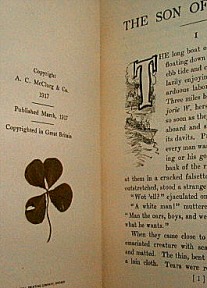
WALK PROUD, MARCI'A, WALK PROUD
March 13: On this day in 1936, author Marci’a Lincoln Rudolph, was born. She was the daughter of Elmo and Ida Linkenhelt and wrote the biography, “My Father, Elmo Lincoln, The Original Tarzan.” Elmo’s real name was Otto Elmo Linkenhelt and Ida Lee Tanchick was his second wife. Emo and Ida were divorced when Marci’a was three years old.
Copies of her book are readily available on EBAY, AMAZON, and other used book websites.
One of the photos with this article is of Marci’a and George McWhorter, lifelong ERB fan, expert, curator of the ERB collection at the University of Louisville, and former publisher of the Burroughs Bulletins. May his thoat be golden may he ride forever under the moons of Mars.
A nice article by Marci’a may be read at: https://www.erbzine.com/mag2/0283.html.
The drabble for today is, “Walk Proud, Marci’a, Walk Proud,” and it is 100 words excerpted from that article.“In the seventh grade I was developing into a young lady. I was taller than most of the other children and even some of my teachers. I started to slouch and stretch my sweaters so no one could see I was developing. Dad spotted that and took me to Hollywood Boulevard. We spent hours watching ladies go by. He pointed out women who walked tall and carried themselves proudly and ones women didn’t carry themselves with pride. He said don’t be embarrassed to be tall. I should walk with pride and always enter a room as though I owned it.” WALK PROUD, MARCI'A, WALK PROUD
As was Argosy’s policy in those days, ERB and ‘Ant Men’ didn’t make the cover for the final installment. The cover illustration (I can’t identify the artist) was for the novel “The Confidence Man” by Laurie York Erskine, which was also a forthcoming movie featuring Tom Meighan, who played several leading-man roles opposite popular actresses of the day, including Mary Pickford and Gloria Swanson. At one point he commanded $10,000 per week. Alas, ‘The Confidence Man is a lost film.”
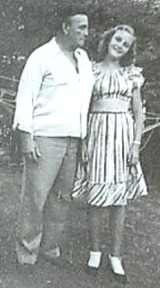
SMALL POTATOES
March 14: On this day in 1924, Argosy All-Story Weekly published the seventh and final installment of “Tarzan and the Ant Men.” https://www.erbzine.com/mag4/0497.html
The drabble for today is, “Small Potatoes,’ and it was inspired by ‘Tarzan and the Ant Men,” “The Wonderful Wizard of Oz,” and Disney’s “Snow White.”Tarzan was captured by the Veltopismakusians, a tribe of the Minunians, and reduced to their size, only a few inches tall, and taken before the Chief of Chiefs, Gofoloso, who said, “Big people are all alike, recklessly trampling our homes without concern. How do you like it now that you’re our size?” SMALL POTATOES
“I getting accustomed to it. Are you people Munchkins? I read about Munchkins. Shouldn’t there be a yellow brick road somewhere.”
“Don’t call me Munchkin.”
“Dwarves then. That’s it. You must be a dwarf.”
“Don’t call me that. I’m not happy.”
“So which one are you then, Grumpy?”
DEATH TO THE IDES
March 15: On this day in 1929, A.C, McClurg published the first edition of “The Monster Men” with a dust jacket and a title page illustration by J. Allen St. John.
The novel was originally published as “A Man Without a Soul” by All-Story Magazine in November 1913.
SPOILER ALERT
In the novel, Professor Arthur Maxon, a mad-scientist, creates humanoid lifeforms in a vat of chemicals (Double, double toil and trouble), but his creatures a are misshapen mentally-deficient monsters. Maxon is determined to create a man-like creature to be married to his daughter, Virginia Maxon. (They’re not related to the comic artist, Rex Maxon.) Number Thirteen is the human looking result.
After many adventures and much danger, Number Thirteen and Virginia have escaped and hidden themselves on the island.
A naval vessel, the “New Mexico arrives and reveals that Number Thirteen was not grown in a vat, but is a wealthy, unmarried, and amnesia suffering. Of course, a victim of a shipwreck. It turns out that Professor Maxon” was not the first or last man to falsify his findings. Number Thirteen, aka Bulan and Townsend J. Harper Jr, and Virginia live happily ever after.
Details about the novel, its publishing history, an electronic version, and several illustrations are at: https://www.erbzine.com/mag7/0756.html
The drabble for today, “Death to the Ides,” was inspired by “The Monster Men” and one really bad day for Julius Caesar a few centuries ago.Bulan saved Virginia from the almost mindless creations of her father and she realized that she loved him whether he was human-born or not. He fell ill and she nursed to back to health. DEATH TO THE IDES
His fever broke and she said, “You’ve been sick for a while. I haven’t seen any of my father’s vile creations and I believe that we’re safe from them, but we can’t take anything for granted. Today is March Fifteenth. Beware the ides of March.”Bulan sat up. “Don’t worry, Virginia. I’ll protect you. Tell me where the ‘ides’ are hiding and I’ll kill them all!”
